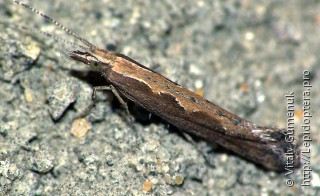Diamondback moths are sterilized to reduce crop loss
Community and Forum → Blog → Diamondback moths are sterilized to reduce crop loss
Lev Bely, 02.07.2012 22:20

The British company Oxitec “updated” diamondback moths (Plutella xylostella) by sterilizing males to reduce crop loss.
Oxitec researchers made genetically modified sterile males which are to mate with non-laboratory, “wild” females of the same species. Due to this modification, females of the next brood don't survive to adult stage.
The company press-release reads that this is just the first stage of the research. It will take few more trials to evaluate the project results and its efficiency.
Scott Meers, an entomologist from the Entomological Society of Alberta finds the work interesting, though he doesn’t know how it could be adapted across Canada’s vast canola acres.
“If it’s anything like other sterile male releases, it’s really, really expensive. It wouldn’t make sense on our extensive canola crops,” he said.
Sterile males are released at times in greenhouses or other closed spaces where they could be somehow observed, but not in fields.
Meers also doubts whether diamondback moths do cause enormous loss of Canadian canola crops. It's hard to count damages in advance since that depends on how many moths overwintered. Those who did are blown with strong south winds northward to Manitoba, Saskatchewan and eastern Alberta. When the weather's good and caterpillars are free to devour young foliage of canola and mustard, there can be million pupaars losses. Opposite, wet and humid conditions restrain the activity of adult moths whilst rains drown small caterpillars.
Thereto, in Canada diamondback moths are bothered with parasitic wasps and farmers who use insecticides hampering moth reproduction.
Jim Broatch with Alberta Agriculture’s Pest management branch says that it's hard to tell if a release of sterile diamondback moths would be effective since most moths come with winds from the USA.
“When would you would release the males? I guess you could figure out in advance. I am not sure how successful it would be or how many you would need to release to impact the population,” said Broatch. “We don’t know how many are going to be blown up.”
The release of sterile coddling moth males (Cydia pomonella) on apple trees in Okanagan was successful, yet the territory was limited.
“It would be a tough one to figure out in how much to invest and how much you would benefit from it (in field crops),” said Broatch.
The Western Producer, http://www.producer.com
Photo: diamondback moth, P. xylostella
All the rest posts on: UK, Pests, Canada, how to, science, technology
Comments
New comment
Note: you should have a Insecta.pro account to upload new topics and comments. Please, create an account or log in to add comments.
* Our website is multilingual. Some comments have been translated from other languages.
Random species of the website catalog
News
- 02.03.2025: Moscow Insect Fair: New section on the Insecta.pro Website
- 31.12.2024: If you need to upload a lot of photos to Insecta.pro website
- 10.12.2024: Новое поле в «Поиске энтомологов»
New photos (26.03.2025)
Fresh from the community
- 12:52, L. Bolshakov: Петр, см. там подробности: https://...
- 12:32, P. Khramov: Лавр, источник скиньте, пожалуйста....
- 23:33, L. Bolshakov: К сожалению, вы поступили неверно. ...
Popular insects
Recommended blog topics
- ICZN Election of Commissioners
- A. Gordon, O. Gorbunov, V. Murzin on Russian TV in 2004
- The first book of Mumbai butterflies



























